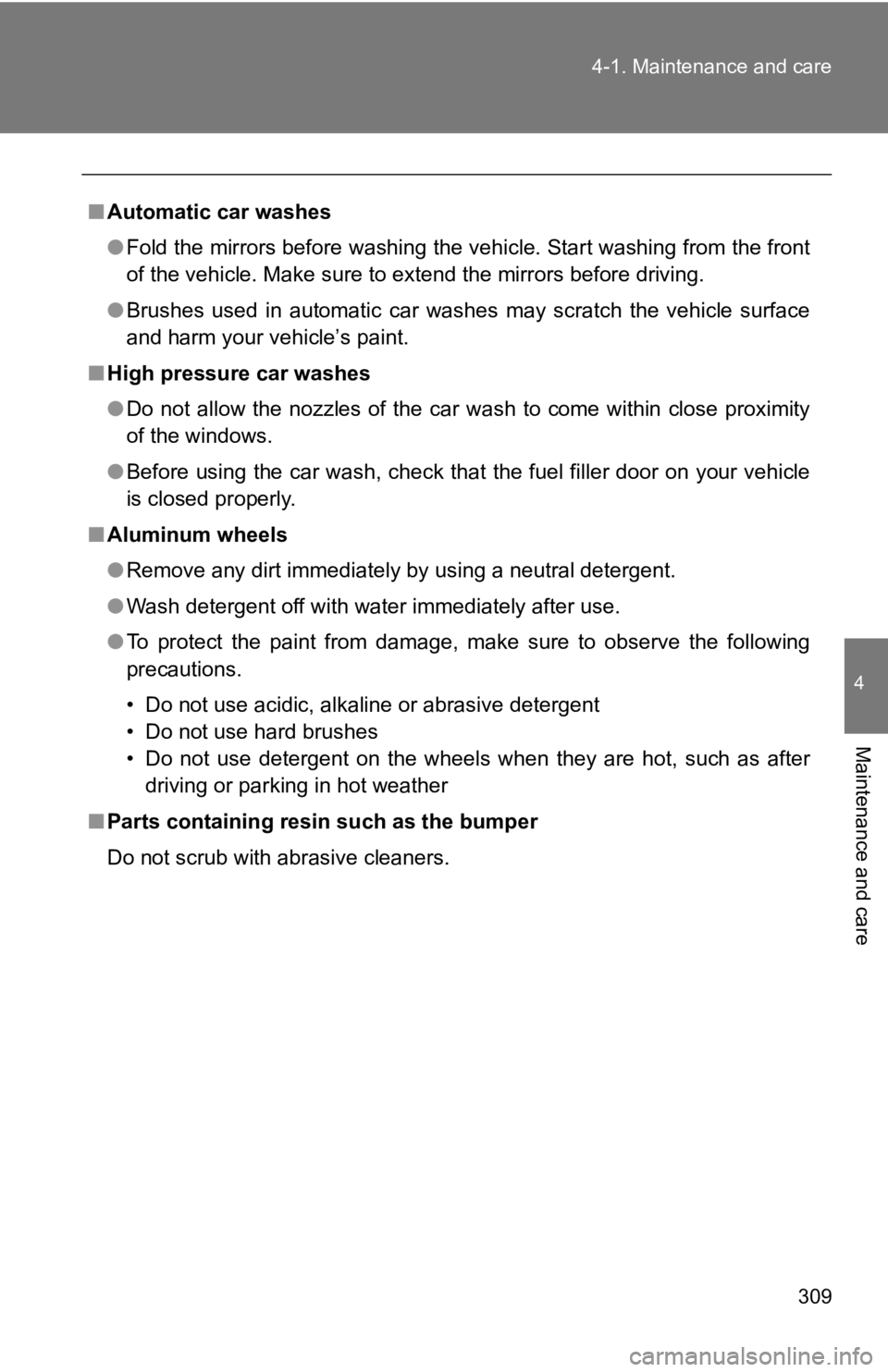Page 309 of 532

309
4-1. Maintenance and care
4
Maintenance and care
■
Automatic car washes
●Fold the mirrors before washing the vehicle. Start washing from the front
of the vehicle. Make sure to extend the mirrors before driving.
● Brushes used in automatic car washes may scratch the vehicle su rface
and harm your vehicle’s paint.
■ High pressure car washes
●Do not allow the nozzles of the car wash to come within close proximity
of the windows.
● Before using the car wash, check that the fuel filler door on y our vehicle
is closed properly.
■ Aluminum wheels
●Remove any dirt immediately by using a neutral detergent.
● Wash detergent off with water immediately after use.
● To protect the paint from damage, make sure to observe the foll owing
precautions.
• Do not use acidic, alkaline or abrasive detergent
• Do not use hard brushes
• Do not use detergent on the wheels when they are hot, such as after driving or parking in hot weather
■ Parts containing resin such as the bumper
Do not scrub with abrasive cleaners.
Page 315 of 532
315
4-1. Maintenance and care
4
Maintenance and care
NOTICE
■
Cleaning the inside of the rear window
●Be careful not to scratch or damage the heater wires.
● Do not use glass cleaner to clean the rear window, as this may cause
damage to the rear window defogger heater wires. Use a cloth da mpened
with lukewarm water to gently wipe the window clean. Wipe the w indow in
strokes running parallel to the heater wires.
■ When cleaning the instrument panel
When small grains of sand and so forth have gotten into instrum ent panel’s
surface and cannot be wiped away using a cloth, use a clay bar without add-
ing water. Forcibly trying to wipe the surface clean with a bru sh or sponge
may scratch the surface or fragments of the cloth may be left i n the surface.
Page 370 of 532
370 4-3. Do-it-yourself maintenance
Fuse layout and amperage ratings■ Engine compartment
FuseAmpereCircuit
1MIR HTR 7.5 A Outside rear view mirror defoggers
2RDI 25 A Electric cooling fan
3(PUSH-AT) 7.5 A Engine control unit
4ABS NO. 1 40 A ABS
5HEATER 50 A Air conditioning system
6WASHER10 A Windshield washer
7WIPER30 A Windshield wipers
8RR DEF30 A Rear window defogger
9(RR FOG) 10 A
10D FR DOOR 25 A Power window (driver’s side)
11(CDS)25 A Electric cooling fan
12D-OP 25 A
13ABS NO. 2 25 A ABS
14D FL DOOR 25 A Power window (passenger’s side)
15SPARESee note. Spare fuse
Page 403 of 532

5
When trouble arises
403
5-2. Steps to take in an emergency
■If the tire pressure warn
ing system is inoperative
The tire pressure warning system will be disabled in the following condi-
tions:
(When the condit ion becomes normal, the system will work properly.)
●If tires not equipped with tire pressure warning valves and tra nsmit-
ters are used.
●If the ID code on the tire pressure warning valves and transmit ters is
not registered in the tire pressure warning computer.
●If the tire inflation pressure is 55 psi (380 kPa, 3.87 kgf/cm2 or bar) or
higher.
The tire pressure warning system may be disabled in the followi ng condi-
tions:
(When the condit ion becomes normal, the system will work properly.)
●If electronic devices or facilities using similar radio wave fr equencies
are nearby.
●If a radio set at similar frequen cies is in use in the vehicle.
●If a window tint that affects the radio wave signals is install ed.
●If there is a lot of snow or ice on the vehicle, in particular around the
wheels or wheel housings.
●If non-genuine Toyota wheels are used. (Even if you use Toyota
wheels, the tire pressure warning system may not work properly with
some types of tires.)
●If tire chains are used.
●If a large metallic object which can interfere with signal reception is
put in the trunk.
■If the tire pressure warning light frequently comes on after bl inking
for approximately one minute
If the tire pressure warning light frequently comes on after bl inking for
approximately one minute when the “ENGINE START STOP” switch is
turned to IGNITION ON mode (vehicles with a smart key system) o r the
engine switch is turned to the “ON” position (vehicles without a smart key
system), have it check ed your Toyota dealer.
Page 448 of 532
448 5-2. Steps to take in an emergency
NOTICE
■When handling jumper cables
Be careful that the jumper cables do not become tangled in the cooling fans
or any of the belts when connecting or disconnecting them.
■ When closing the doors
While pushing the door glass towards the inside of the vehicle, slowly close
the door.
Because the side window open/close function linked to door oper ation will
not operate, the window may interfere with the vehicle body, po ssibly
scratching both the vehicle body and window, or even shattering the window.
Page 480 of 532

480 6-1. Specifications
Warning: The temperature grades of a tire assume that it is properly
inflated and not overloaded.
Excessive speed, underinflation, or excessive loading, either s epa-
rately or in combination, can cause heat buildup and possible t ire fail-
ure.
Glossary of tire terminology
Tire related termMeaning
Cold tire inflation
pressure Tire pressure when the vehicle has been
parked for three hours or more, or has not
been driven more than 1
mile or 1.5 km under
that condition
Maximum inflation
pressure The maximum cold inflated pressure to which a
tire may be inflated, shown on the sidewall of
the tire
Recommended
inflation pressure Cold tire inflation pressure recommended by a
manufacturer.
Accessory weight The combined weight (i
n excess of those stan-
dard items which may be replaced) of auto-
matic transmission, po wer steering, power
brakes, power windows, power seats, radio
and heater, to the exten t that these items are
available as factory-installed equipment
(whether installed or not)
Curb weight The weight of a
motor vehicle with standard
equipment, including th e maximum capacity of
fuel, oil and coolant, and if so equipped, air
conditioning and additional weight optional
engine
Maximum loaded
vehicle weight The sum of:
(a) Curb weight
(b) Accessory weight
(c) Vehicle capacity weight
(d) Production options weight
Page 489 of 532
489
6-2. Customization
6
Vehicle specifications
Alarm
(
P. 82)
Operation when doors
are unlocked using the
mechanical key (vehi-
cles with a smart key
system)
Off On
Automatic
light control
system
( P. 222) Light sensor sensitivity ±0% -40% to +40%
Time elapsed before
headlights automati-
cally turn off after doors
are closed
30 seconds0 second
60 seconds
90 seconds
Rear window
defogger
(
P. 284) Time elapsed before
the rear window defog-
ger turn off (vehicles
with an automatic air
conditioning system)
15 minutes Continue
Illumination
(
P. 289) Time elapsed before
lights turn off
15 seconds7.5 seconds
30 seconds
Operation when the
doors are unlocked On Off
Operation after the
engine switch is turned
off On Off
Interior light illumination
upon approach (vehi-
cles with a smart key
system) On Off
Interior light illumination On Off
ItemFunctionDefault settingCustomized setting
Page 522 of 532

522 Alphabetical index
Brake assist .............................. 245
Break-in tips ............................. 155
Brightness controlInstrument panel light control ................................. 192
Care Alcantara
®............................. 316
Aluminum wheels .................. 309
Exterior .................................. 308
Interior ................................... 312
Seat belts .............................. 313
Cargo capacity ......................... 256
Chains ....................................... 263
Child restraint system Booster seats,
definition ............................. 137
Booster seats, installation ........................... 141
Convertible seats, definition ............................. 137
Convertible seats,
installation ........................... 141
Front passenger occupant classification system ........... 128
Infant seats, definition ............................. 137
Infant seats,
installation ........................... 141
Installing CRS with LATCH anchors .................. 142
Installing CRS with seat belts ............................ 144
Installing CRS with
top tether straps .................. 147 Child safety
Airbag precautions ................ 120
Battery precautions ....... 342, 447
Child restraint system ........... 137
How your child should
wear the seat belt ................. 62
Installing child restraints........ 141
Power window lock switch ...... 72
Power window precautions ........................... 74
Removed key battery
precautions ......................... 365
Seat belt guide ........................ 61
Seat belt precautions .............. 64
Seat heater precautions ........ 302
Trunk precautions ................... 49
Cleaning
Alcantara
®............................. 316
Aluminum wheels .................. 309
Exterior.................................. 308
Interior ................................... 312
Seat belts .............................. 313
Clock ......................................... 298
Condenser ................................ 337
Console tray ............................. 294
Coolant
Capacity ................................ 464
Checking ............................... 335
Cooling system
Engine overheating ............... 449
Cruise control .......................... 232
Cup holders .............................. 294
Curtain shield airbags ............... 89
Customizable features ............ 487
Daytime running light system .................................... 224
Defogger Rear window ......................... 284
Side mirror ............................ 284
C
D